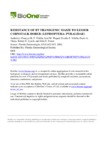Por favor, use este identificador para citar o enlazar este ítem:
http://www.alice.cnptia.embrapa.br/alice/handle/doc/473548Registro completo de metadatos
| Campo DC | Valor | Lengua/Idioma |
|---|---|---|
| dc.contributor.author | VILELLA, F. M. F. | pt_BR |
| dc.contributor.author | WAQUIL, J. M. | pt_BR |
| dc.contributor.author | VILELLA, E. F. | pt_BR |
| dc.contributor.author | VIANA, P. A. | pt_BR |
| dc.contributor.author | LYNCH, R. E. | pt_BR |
| dc.contributor.author | FOSTER, J. E. | pt_BR |
| dc.date.accessioned | 2016-06-23T07:16:13Z | - |
| dc.date.available | 2016-06-23T07:16:13Z | - |
| dc.date.created | 2003-10-22 | pt_BR |
| dc.date.issued | 2002 | pt_BR |
| dc.identifier.citation | Florida Entomologist, Gainesville, v. 85, n. 4, p. 652-653, 2002. | pt_BR |
| dc.identifier.uri | http://www.alice.cnptia.embrapa.br/alice/handle/doc/473548 | pt_BR |
| dc.description | To determine if Bt maize seedlings are protected against lesser cornstalk borer damage, Bt hybrids at the 3 and 4 leaf stages were tested under temperatures between 20-32oC and artificial infestation. A high level of resistance was reported in all Bt maize as expressed by larval survival, larval weight, damage score, and number of surviving plants. All Bt maize protected plants against lesser cornstalk borer damage. Also, the resistance present in the Bt maize was not affected by daytime temperature. | pt_BR |
| dc.language.iso | eng | eng |
| dc.rights | openAccess | eng |
| dc.subject | Transgênico | pt_BR |
| dc.title | Resistance of Bt transgenic maize to lesser cornstalk borer (Lepidoptera: Pyralidae). | pt_BR |
| dc.type | Artigo de periódico | pt_BR |
| dc.date.updated | 2018-06-05T11:11:11Z | pt_BR |
| dc.subject.thesagro | Milho | pt_BR |
| riaa.ainfo.id | 473548 | pt_BR |
| riaa.ainfo.lastupdate | 2018-06-05 -03:00:00 | pt_BR |
| dc.contributor.institution | PAULO AFONSO VIANA, CNPMS. | pt_BR |
| Aparece en las colecciones: | Artigo em periódico indexado (CNPMS)  | |
Ficheros en este ítem:
| Fichero | Descripción | Tamaño | Formato | |
|---|---|---|---|---|
| Resistancetransgenic.pdf | 42.14 kB | Adobe PDF |  Visualizar/Abrir |









